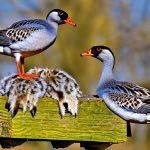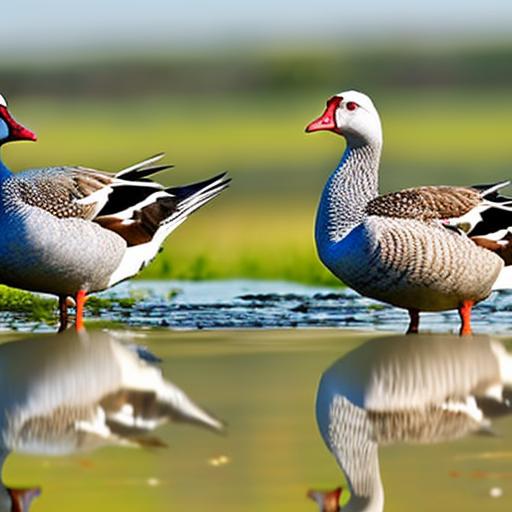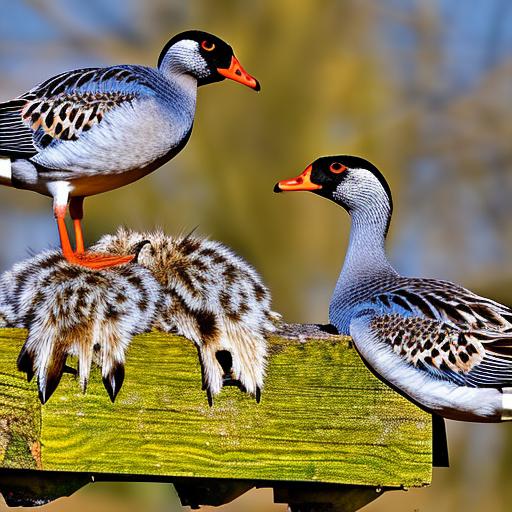Geese breeding is a fascinating and rewarding endeavor that has been practiced for centuries. Geese are known for their strong family bonds and nurturing instincts, making them excellent parents. Breeding geese can be a fulfilling experience for both hobbyists and commercial breeders, as it allows them to witness the entire life cycle of these majestic birds. From selecting the right breeding stock to nurturing and rearing goslings, geese breeding requires careful planning and attention to detail. Understanding the intricacies of geese breeding can lead to successful outcomes and healthy, thriving flocks.
Geese are social birds that thrive in a communal environment, making them well-suited for breeding in groups. They are also known for their strong homing instincts, which can be advantageous for breeders looking to establish a stable and loyal flock. Geese breeding can be a profitable venture for those looking to produce meat, eggs, or down feathers, as geese are valued for their high-quality products. Additionally, geese are often raised for conservation purposes, as they play a vital role in maintaining ecological balance and biodiversity. Overall, geese breeding offers a unique opportunity to connect with nature and contribute to the preservation of these remarkable birds.
Selecting the Right Breeding Stock
Selecting the right breeding stock is crucial for successful geese breeding. When choosing breeding geese, it is important to consider their health, temperament, and genetic traits. Healthy and robust geese are more likely to produce strong and resilient offspring, ensuring the long-term viability of the flock. Additionally, selecting geese with desirable temperaments can make the breeding process more manageable and enjoyable for breeders. Geese that are docile and easy to handle are ideal for both commercial and hobbyist breeders.
Genetic traits also play a significant role in selecting breeding stock. Breeders should aim to preserve and improve desirable traits such as size, conformation, and coloration. By carefully selecting breeding geese with these traits, breeders can work towards producing high-quality offspring that meet breed standards and market demands. It is also important to consider the genetic diversity of the breeding stock to prevent inbreeding and maintain the overall health and vigor of the flock. Overall, selecting the right breeding stock is a critical step in geese breeding that requires careful consideration and attention to detail.
Creating the Ideal Nesting Environment
Creating the ideal nesting environment is essential for successful geese breeding. Geese are known for their strong nesting instincts and will seek out suitable locations to build their nests. For breeders, providing nesting boxes or shelters can help encourage geese to lay their eggs in a safe and secure environment. Nesting boxes should be spacious enough to accommodate the nesting goose and her eggs, with ample bedding material to keep the eggs warm and protected.
In addition to providing nesting boxes, breeders should also ensure that the nesting area is free from potential predators and disturbances. Geese are protective of their nests and will defend them fiercely, so it is important to create a peaceful and secluded environment for nesting geese. This can be achieved by placing nesting boxes in quiet and secluded areas away from high-traffic areas or potential threats. By creating the ideal nesting environment, breeders can help ensure the safety and well-being of nesting geese and their eggs, leading to successful hatching and rearing of goslings.
The Importance of Incubation and Hatching
Incubation and hatching are critical stages in geese breeding that require careful attention and monitoring. After a goose has laid her eggs in the nesting box, it is important to provide proper incubation conditions to ensure the eggs develop and hatch successfully. This can be achieved by using an incubator or allowing the nesting goose to incubate her eggs naturally. In either case, maintaining consistent temperature and humidity levels is essential for the healthy development of the embryos.
During the incubation period, breeders should regularly check the eggs for signs of development and monitor the nesting goose’s behavior to ensure she is caring for her eggs properly. It is important to provide the nesting goose with access to food and water during this time to support her nutritional needs as she incubates her eggs. As the hatch date approaches, breeders should be prepared to assist with hatching if necessary, as some goslings may require assistance breaking free from their shells.
Once the goslings have hatched, it is important to provide them with a warm and safe environment to promote their health and well-being. This can be achieved by providing brooder lamps or heat sources to maintain optimal temperature levels for the goslings. Additionally, providing access to clean water and nutritious feed is essential for supporting the growth and development of the goslings. By understanding the importance of incubation and hatching, breeders can help ensure the successful transition of goslings from eggs to healthy young geese.
Nurturing and Rearing Goslings
Nurturing and rearing goslings is a rewarding aspect of geese breeding that requires patience and dedication. After hatching, goslings rely on their parents or caregivers for warmth, protection, and nourishment. It is important to provide goslings with a safe and comfortable environment that meets their basic needs for food, water, shelter, and social interaction. This can be achieved by providing access to a brooder or sheltered area with appropriate bedding material, heat sources, and access to clean water and nutritious feed.
As goslings grow and develop, they will begin to explore their surroundings and exhibit natural behaviors such as grazing, swimming, and socializing with other goslings. It is important to provide goslings with opportunities for exercise and enrichment to support their physical and mental well-being. This can be achieved by allowing goslings access to outdoor areas with grassy pasture or access to ponds or water sources for swimming.
In addition to providing for their physical needs, it is important to monitor the health of goslings regularly and address any potential issues promptly. This can include observing their behavior, checking for signs of illness or injury, and providing appropriate veterinary care when necessary. By nurturing and rearing goslings with care and attention, breeders can help ensure the healthy development of young geese as they grow into mature adults.
Health and Nutrition for Growing Geese
Health and nutrition are essential components of successful geese breeding, as they directly impact the growth, development, and overall well-being of growing geese. Providing a balanced diet that meets the nutritional needs of growing geese is crucial for supporting their health and vitality. This can be achieved by offering a combination of high-quality feed, fresh water, and access to natural grazing areas or pasture.
When selecting feed for growing geese, it is important to choose options that are specifically formulated for waterfowl and provide essential nutrients such as protein, vitamins, minerals, and energy sources. Additionally, offering access to fresh water at all times is essential for supporting proper digestion, hydration, and overall health. Providing access to natural grazing areas or pasture can also supplement their diet with additional nutrients from grasses, plants, insects, and other natural sources.
In addition to nutrition, maintaining good health in growing geese requires regular monitoring for signs of illness or injury. This can include observing their behavior, checking for physical abnormalities or changes in appetite or activity levels, and providing appropriate veterinary care when necessary. By prioritizing health and nutrition for growing geese, breeders can help ensure the long-term well-being of their flocks.
Tips for Successful Geese Breeding and Rearing
Successful geese breeding and rearing requires careful planning, attention to detail, and dedication from breeders. To achieve success in geese breeding, it is important to prioritize the health and well-being of breeding stock, provide an ideal nesting environment for nesting geese, support proper incubation and hatching processes, nurture and rear goslings with care and attention, prioritize health and nutrition for growing geese.
Additionally, establishing good management practices such as regular monitoring of flock health, providing access to clean water and nutritious feed, maintaining proper sanitation in living areas, addressing potential issues promptly through veterinary care when necessary can contribute to successful outcomes in geese breeding.
Furthermore, staying informed about best practices in geese breeding through resources such as books, articles, workshops or connecting with experienced breeders can provide valuable insights into effective strategies for successful geese breeding.
In conclusion, geese breeding offers a unique opportunity to connect with nature while contributing to conservation efforts or producing high-quality products such as meat or down feathers. By understanding the intricacies of geese breeding from selecting the right breeding stock to nurturing growing goslings with care breeders can achieve successful outcomes in geese breeding while promoting the health vitality of their flocks.
Meet Walter, the feathered-friend fanatic of Florida! Nestled in the sunshine state, Walter struts through life with his feathered companions, clucking his way to happiness. With a coop that’s fancier than a five-star hotel, he’s the Don Juan of the chicken world. When he’s not teaching his hens to do the cha-cha, you’ll find him in a heated debate with his prized rooster, Sir Clucks-a-Lot. Walter’s poultry passion is no yolk; he’s the sunny-side-up guy you never knew you needed in your flock of friends!







